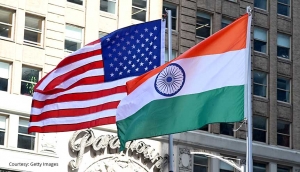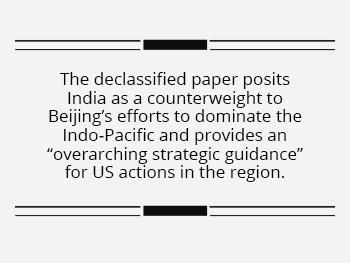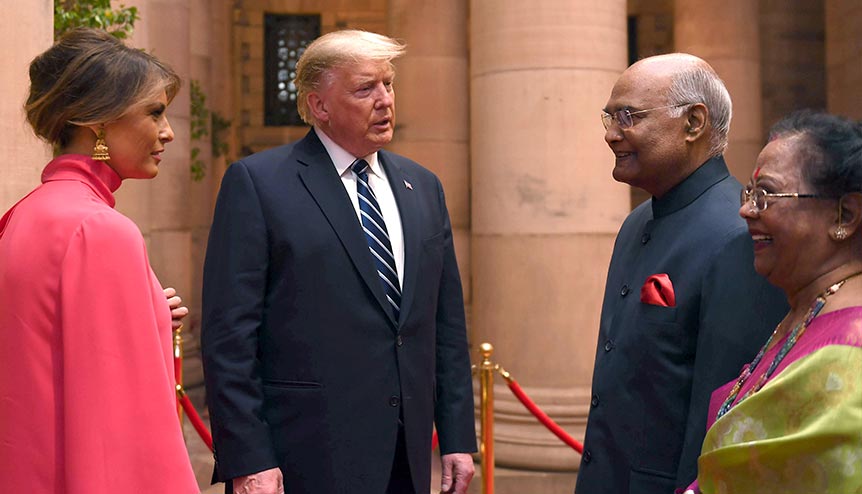
The ‘United States Strategic Framework for the Indo-Pacific’ document talks of building up India’s capabilities and posit it as a counterweight to China. Though authored by the Trump administration, the strong strategic convergence between New and Washington is expected to ensure that the Biden administration doesn’t make too many changes to it.
India plays a central role in the US’s Indo-Pacific strategy, which is aimed at ensuring continued US dominance over China in the strategic, military, diplomatic and technological spheres, a recently declassified US document titled “United States Strategic Framework for the Indo-Pacific” has said.

The goal of the strategy paper is to ensure that the US and its allies do everything in their power to ensure “the Indo-Pacific region (stays) free and open long into the future”.
Though the strategy has been framed by the Trump administration, Indian diplomatic and strategic circles do not expect any substantial changes in its fine print under the Joe Biden administration that will take office on January 20.
“The US strategic community, cutting across party lines is now wary about the rise of China and its ability to challenge US authority at least in Asia and parts of the Pacific Ocean. So, even if the new Biden administration tweaks this strategy paper and makes cosmetic changes to claim ownership over it, the broad objective of containing China and the fine print of how to do it is unlikely to change,” said member of the Indian diplomatic community on condition of anonymity.

Former US President Donald Trump along with Melania Trump, President Ram Nath Kovind and First Lady Savita Kovind at Rashtrapati Bhavan. Though the report has been framed by the Trump administration, Indian diplomatic and strategic circles do not expect any substantial changes in its fine print under the Joe Biden administration.
“There is broad bipartisan support in the US for closer strategic and economic ties with India, which are based on shared interests, not personal ideologies. So, we don’t expect a Biden administration to make any wholesale changes to policies impacting India,” a senior official in the government had told IGB soon after the US elections.
“Beijing is increasingly pressuring Indo-Pacific nations to subordinate their freedom and sovereignty to a ‘common destiny’ envisioned by the Chinese Communist Party. The US approach is different. We seek to ensure that our allies and partners – all who share the values and aspirations of a free and open Indo-Pacific — can preserve and protect their sovereignty,” the media quoted O’Brien as saying.
Two of them, in particular, are likely to find a chilling resonance in the power corridors of New Delhi. According to a Bloomberg report, the document says:
* “China seeks to dominate cutting-edge technologies, including artificial intelligence and bio-genetics, and harness them in the service of authoritarianism. Chinese dominance in these technologies would pose profound challenges to free societies,” and
* “China will take increasingly assertive steps to compel unification with Taiwan.”
Vice Chief of Army Staff Lt. Gen. S K Saini interacts with the US Army 25th Infantry Division Lightning Academy after witnessing Jungle Training and Chinook Helicopter Sling Load Carriage in October 2020.
Given the wariness of Indian military and strategic planners about a collusive threat from a China-Pakistan axis and the possibility of being drawn into a two-front war stretching from Arunachal Pradesh in the east to Rajasthan and Gujarat in the West, China’s technological advancements in fields like AI and bio-genetics, which can be force multipliers on the battlefield.
A senior security analyst said India will have to step up its research efforts and funding in these areas and also involve both the private sector and seek foreign collaborations as it tries to catch up with its northern rival.
Indian Navy holds passage exercise with US Navy’s Nimitz Aircraft Carrier in the Indian Ocean. The United States Strategic Framework for the Indo-Pacific identifies India as the US’ preferred partner to preserve maritime security and counter Chinese influence in South and Southeast Asia and other regions of mutual concern.
The observation that “China will take increasingly assertive steps to compel unification with Taiwan” will also worry the Indian security establishment. If the US stands firmly behind Taiwan, and China gets bogged down in a long-drawn military conflict on its eastern seaboard, it might be tempted to undertake a military misadventure across the Line of Actual Control (LAC) to divert its people’s attention from its failures there.
In the light of the above, Indian planners will be satisfied with US observations about India. The Bloomberg report quotes the document as saying: “India’s preferred partner on security issues is the United States. The two cooperate to preserve maritime security and counter Chinese influence in South and Southeast Asia and other regions of mutual concern… India remains preeminent in South Asia and takes the leading role in maintaining Indian Ocean security.”
The document adds that the US “strengthen the capacity of emerging partners in South Asia, including the Maldives, Bangladesh, and Sri Lanka, to contribute to a free and open order”.
All these countries are India’s allies in the region. So, there is a huge amount of complementarity in the strategic visions of the two countries.
The Indian establishment is now waiting to see what changes, if any, the incoming Biden administration makes in this strategic document.
UK Ministers, Shadow Cabinet leaders, diplomats, business chiefs come together for India Global Forum’s grand Diwali Reception in London Read… Read More
At the India Global Forum’s (IGF) grand Diwali reception in London this week, UK Home Secretary Suella Braverman focussed her message of… Read More
Home Secretary Suella Braverman has said the UK is eager to secure a trade deal with India to boost both… Read More
Chandrasekhar also attended a session on the Future of Digital at the India Global Forum where he spoke on the… Read More
India Global Forum’s glittering awards ceremony with Guest of Honour, UK Chancellor Rishi Sunak, to mark the culmination of a… Read More
The UK government on Wednesday announced 75 fully-funded scholarships for Indian students to study in the UK, beginning September 2022,… Read More
View Comments